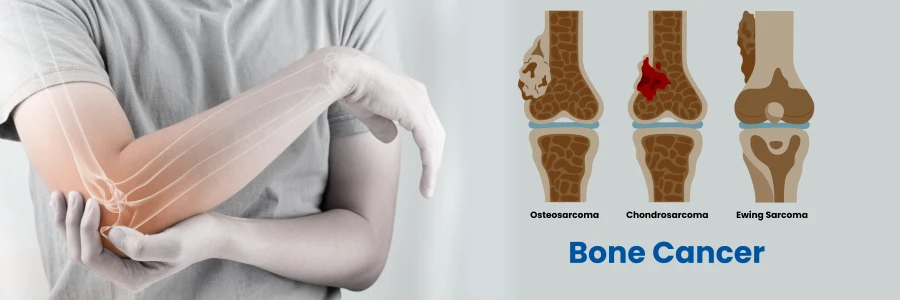
Bone cancer
Bone tumors grow when cells in the bone divide uncontrollably, forming a mass of tissue. While most bone tumors are benign and do not spread to other areas of the body, they can still weaken the bones and lead to fractures or cause other problems. Bone cancer destroys normal bone tissue. It can start in the bone or spread from other parts of the body (called metastasis). Osteoma is a type of bone cancer that usually affects the skull and legs in children and young adults, usually under 20 years of age. however, it can be found elsewhere. of the body. It is rarely seen in old age. An osteoma involves the growth of a new piece of bone that grows over a piece of bone. It is a benign tumor. When the bone tumor grows another bone is known as "homoplastic osteoma"; when it grows in other tissues it is called a "heteroplastic osteoma."
Osteoma can be divided generally into two types:
1.Compact osteomas made up of mature lamellar bone.
2.Spongy osteomas are made up of trabecular bone with bone marrow. The cause of osteomas is unknown, but embryological, stressful, or viral causes are suggested by widely recognized hypotheses. Osteomas are also found in Gardner syndrome. Larger craniofacial osteomas can cause facial pain, headache, and infection due to blocked nasofrontal tubes. Oftentimes, a craniofacial osteoma presents through ocular signs and symptoms.
Bone Cancer Symptoms
The pressure that can be alleviated with over-the-counter (OTC) pain relievers in the early stages is the most frequent symptom of osteoma. Once the benign tumor develops further, the pain cannot be relieved with over-the-counter medications. At this stage, we often see swelling. However, the pain level stays the same for years in some cases and the doctor can prescribe specific medications to keep pain at bay. The tumor is often found by X-ray imaging. Osteoid osteomas, characterized by being less than 1.5 cm in diameter, occur most often in young men and may occur in any bone in the body. Severe pain usually occurs at night, but it can also be constant at any time of the day. The main complaint may be only a dull pain that does not radiate and is persistent but increases significantly at night, which can be managed with medications prescribed by the doctor.
Apart from this, the other symptoms are:
- Dull pain that increases to severe at night OR a mild pain that increases to severe even at night and affects the quality of sleep
- limping
- muscle atrophy
- Arched deformity
- Swelling
- Increased or decreased bone growth
Causes
Osteoblasts are cells in our body responsible for the formation of new bone. The excess bone associated with osteoid osteoma is made up of osteoid bone, a different type of bone that we don't normally see overgrowth. The osteoid osteoma also secretes prostaglandins, a chemical signaling molecule in our bodies that is often associated with causing pain.
Particularly associated with osteoid osteoma are several other conditions:
- Osteomyelitis This is a bone infection that is easily differentiated from an osteoid osteoma with imaging.
- Stress Fractures Unlike osteoid osteoma, pain from a stress fracture is often worse with activity.
- Osteoblastoma An osteoblastoma is another non-cancerous, bone-forming tumor, but it is most commonly found in the spine, usually larger than 2 centimeters and pain,It does not usually improve with aspirin. They are readily distinguished from osteoid osteomas by these symptoms.
Diagnosis
- X-ray Most osteoid osteomas are diagnosed by X-rays, in which the tumor usually appears as a small area of thickened bone around a central nucleus.
- CT or MRI scans Approximately 25 percent of osteoid osteomas are not visible on x-rays because the thickened bone has obscured the image and therefore will require these additional imaging methods, CT scans and/or MRIs.
- Biopsy A biopsy is a small sample of bone that is usually removed with a needle. They are rarely required for osteoid osteoma diagnosis to be confirmed
Treatment
The osteoma can resolve spontaneously in approximately 33 months, the reason for which is unknown. However, in an unusual situation, the tumor, and the discomfort it induces apparently continued continuously for 9 years before the tumor was eventually identified and removed, curing the patient. Therefore, it may never resolve on its own. The type of treatment can also vary depending on the health of the person with the tumor. If a person is healthy and willing to endure pain, pain relievers are given until the tumor resolves, unless the pain keeps them awake at night. If the patient does not want to endure pain or be treated with non-steroidal anti-inflammatory drugs, surgical or percutaneous ablation may be considered. If surgery is preferred, the individual can be referred to an orthopedic surgeon for ablation. Therapy and strengthening may be needed after surgery, depending on the location of the tumor and the health of the individual. Currently, percutaneous radiofrequency ablation is the preferred treatment option. It is a minimally invasive procedure in which radio frequencies are passed under the skin through a needle to kill tumor cells by heating them to a high temperature. It is performed by a radiologist and is preferred because it is performed under general anesthesia and does not weaken the bone as much as surgery does. For this procedure, recuperation time is often shorter. Although pain can be relieved with medication, ablation may need to be done in some more severe cases.
